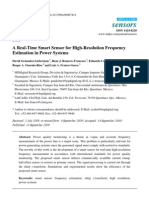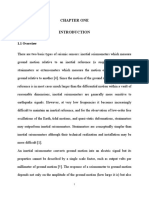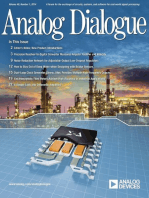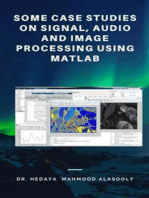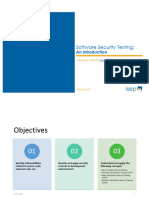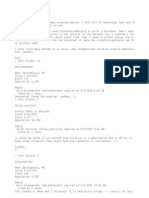Sensors and Signal Conditioning
Sensors and Signal Conditioning
Uploaded by
nazwamaha2612Copyright:
Available Formats
Sensors and Signal Conditioning
Sensors and Signal Conditioning
Uploaded by
nazwamaha2612Copyright
Available Formats
Share this document
Did you find this document useful?
Is this content inappropriate?
Copyright:
Available Formats
Sensors and Signal Conditioning
Sensors and Signal Conditioning
Uploaded by
nazwamaha2612Copyright:
Available Formats
Display,
Sensor actuators,
Input Processing Output
signals,
control
Sensors and Signal
Conditioning
Part 4 in a series of tutorials in
instrumentation and measurement
John L. Schmalzel and David A. Rauth
Transfer Function
I
n Part 2 [1], Kim Fowler and John Schmalzel intro-
duced many of the common sensor strategies that con- One of the easiest ways to visualize the behavior of an
stitute the first stage in the measurement chain; in Part element is through an I/O graphical relationship, as
3 [2], Thomas Bajzek provided details on thermocou- shown in Figure 1. Many common behaviors can be
ples (TCs). The challenge we take up in this fourth install- compactly summarized using this technique. The
ment is to consider how to make a sensor work in a examples show linear gain, gain with saturation, dead
measurement system. Signal conditioning broadly zone, and hysteresis.
includes the steps needed to make the sensor A deeper understanding of what a signal-
an active part of a measurement system conditioning element does and how it
by providing excitation, if required, and works can best be accomplished if we
then performing the preliminary use a transfer function to model its
actions needed to obtain a signal that behavior as a mathematical function.
can be processed. What’s done to Equation (1) gives a standard form
and with that signal is the subject of of the function:
future parts of this tutorial series.
Luckily, we don’t have to wait that
V 0 (s)
long to get results, because the output T(s) = . (1)
V 1 (s)
of the signal conditioning stage can be
used for something as simple as driving a
display subsystem so that we see results. The transfer function T(s) is the ratio of
Signal conditioning is a critical step in a mea- the output function Vo(s) to the input function
surement system but so is each element as emphasized by Vi (s); s is the complex frequency variable. An overall
the serial model we have been using so far to depict the T(s) is designed to achieve the desired I/O relation-
basic elements of an instrument. However, it is important ship for the sensor and in consideration of the applica-
to keep in mind that many overall performance limits of a tion. Typically, such transfer functions are
measurement are strongly influenced by what happens in complicated if they accurately model the system
the signal conditioning stage. For example, linearity, behavior, but there are several simple forms that pro-
accuracy, noise rejection, and long-term drift behaviors vide a surprising match to a number of common sys-
will be strongly affected by decisions made here. tem behaviors.
48 IEEE Instrumentation & Measurement Magazine June 2005
1094-6969/05/$20.00©2005IEEE
Display,
Sensor actuators,
Input Processing Output
signals,
control
Zero-Order Systems necessary for low-bandwidth sensors. Conversely, it is impor-
A linear potentiometer coupled to a physical link is one way tant to have high-bandwidth signal conditioning for sensors
to construct a sensor for displacement. In this case, the transfer with corresponding high bandwidths.
function can be modeled as
Kx Output
T0 = . (2) Dead Zone
X
Linear Gain
The zero-order transfer function of (2) is not a function of
frequency; it is proportional to some scaling constant, K, and
Hysteresis
the ratio of the displacement, x, to the total displacement full
scale, X.
First-Order Systems Gain with Saturation
Many sensor systems can be modeled with a single time con-
stant. Although we know that all systems are complex, it is
often possible to get good results with a simplified model. Input
For example, a system with low-pass behavior may be
accurately modeled with a single response pole, especially if Fig. 1. Examples of I/O relationships for different signal conditioning
it is much lower in frequency than other response elements. phenomena.
One possible model for a first-order system is
K 0
T1 (s) = s . (3)
1+ –5
ω0
–10
Magnitude (dB)
K is a scaling constant and ω0 is the corner frequency of the sin- –15
gle time constant system. Since the behavior of this system is fre- –20
quency dependent, it is useful to determine the magnitude and –25
phase responses. A common graphical method used to visualize –30
these behaviors is the Bode plot, which shows how transfer
–35
functions respond as functions of frequency. Figure 2(a) shows
–40
the magnitude response for an example first-order system.
–45
-1 0 1 2
Second-Order Systems 10 10 10 10
Another common physical model contains two energy storage Frequency (rad/s)
elements such as capacitance and inductance. Second-order (a)
40
systems develop a richer variety of response forms; exhibiting
behaviors such as damped sinusoidal oscillations, for exam-
20
ple. The model for one form of second-order system is
Magnitude (dB)
0
2
Kω0
T2 (s) = . (4) –20
ω0
s2 + s + ω0 2
Q –40
–60
As before, K is a scaling constant, ω0 is the undamped natu-
ral frequency of the system, and Q is a quality term that –80 2
–1 0 1
describes the behavior around ω0 . Since the behavior of this 10 10 10 10
system is frequency dependent, a Bode plot can be used to Frequency (rad/s)
illustrate its behavior, as shown in Figure 2(b). (b)
Users and designers of measurement systems keep these
models in mind to ensure that the frequency response is Fig. 2. (a) First-order system magnitude frequency response (ω0 = 1 rad/s,
appropriate to the physical system that is being measured. For K = 1). (b) Second-order system magnitude frequency response (ω0 = 1
instance, high-bandwidth signal conditioning elements are not rad/s, K = 1, Q = 10).
June 2005 IEEE Instrumentation & Measurement Magazine 49
The Electronics of Signal Conditioning ◗ linearize the signal to simplify information extraction
There are a number of key functions that the instrument ◗ reject noise to improve the signal-to-noise ratio (SNR)
needs to perform, which are often assigned as signal condi- ◗ afford protection to limit damage to the instrument
tioning functions: from electrostatic discahrge (ESD).
◗ provide sensor excitation (for those requiring it) Table 1 lists some routine signal conditioning functions.
◗ provide an input stage with characteristics matched to Table 2 selects sensors from an earlier tutorial [1] and sug-
the sensor gests further details on the likely signal conditioning ele-
◗ detect the input signal ments for each. Table 3 gives examples of signal
◗ translate the input signal to a range and magnitude conditioning for various sensors.
compatible with later signal processing and data
conversion tasks Excitation
When required, excitation can be dc, ac, or
Table 1. Typical signal conditioning functions. some combination of both. Excitation can be
a source of instrumentation errors. The full-
Signal Conditioning
scale response of a bridge transducer (com-
Category Example Function
posed of strain gauge elements), for
Excitation dc source for sensor example, is typically reported as k mV/V;
ac source for sensor i.e., for a full-scale signal input, k mV of out-
Input matching High-impedance amplifier for high-impedance put is produced for each volt of excitation.
sensors To increase the effective gain of the sensor,
Matched-impedance inputs for complex- you might be tempted to increase the excita-
impedance sensors tion voltage arbitrarily. However, an upper
Signal translation Amplification for low-level signals limit is usually recommended by the sensor
Offset or ac-coupling for signals with dc offset manufacturer to avoid self-heating and
Signal detection Synchronous detection for signals modulating a other second-order errors. Another consid-
carrier eration is warm-up time. Low-power sys-
Linearization Curve fitting for nonlinear signals tems may need to power a sensor on and off;
Piecewise gain fitting it is important to ensure that the response of
Noise rejection Filtering (low-pass, high-pass, band-pass) the sensor has stabilized prior to making
Protection Transient suppression networks measurements.
Table 2. Signal conditioning support for typical sensors.
Sensor Excitation Input- Translation Detection Linearization Noise
Impedance
Strain gauge dc Hi-Z Amplification Direct No Low-pass
differential
LVDT ac Lo-Z No Synchronous No Band pass
Piezoelectric No Hi-Z I to V Direct No Low pass
Potentiometer dc Lo-Z No Direct No Low pass
Turbine flowmeter No Lo-Z No Direct No Band pass
Electrochemical cell No Hi-Z No Direct No Low pass
Photodiode No Hi-Z No Direct No Low pass
Phototransistor dc (bias) Lo-Z No Direct Yes No
Capacitive ac Hi-Z Amplification Synchronous Yes Band pass
Microphone dc Hi-Z AC-coupled Direct No No
(electret) Amplification
Thermocouple No Hi-Z Amplification Direct Yes Low-pass
differential
Thermistor dc Lo-Z No Direct Yes Low-pass
RTD dc Lo-Z Amplification Direct No Low-pass
differential
Notes—dc: Direct Current; ac: Alternating Current; Hi-Z: High impedance; Lo-Z: Low impedance.
50 IEEE Instrumentation & Measurement Magazine June 2005
Display,
Sensor actuators,
Input Processing Output
signals,
control
Input Matching Table 3. Signal conditioning support for typical sensors.
The sensor network model
needs to be considered Sensor Signal Conditioning
when the input stage is Thermocouples Single pole low-pass filtering and amplification
selected. In general, most Strain gauge Voltage excitation, single-pole low-pass filtering and buffering
signal conditioning front MEMS accelerometer Sharp cut-off low-pass filtering
ends will have a high-input Photodiode Optical band-pass filtering and voltage excitation
impedance to provide maxi- Microphone Voltage excitation, sharp band-pass filtering, and amplification
mum compatibility with
high-impedance sensors.
produces an output voltage proportional to pressure; how-
Translation ever, the useful output would be expressed in kilopascal. A
The input signal must be translated to levels compatible sensor exhibiting a linear response requires the least amount
with later processing stages. It is possible that no translation of postprocessing to change the signal to that useful output.
is required; for example, some sensor systems produce out- Linearization once was largely performed using additional
puts that are of sufficient magnitude to be directly converted circuitry as part of the signal conditioning stage; now it is
or otherwise sensed. In many other cases, amplification is typical for linearization to be performed as a signal process-
required to increase the magnitude of the signal to better fit ing step using an analytic model for the sensor, detailed
the full-scale input range and resolution requirements of look-up tables, or other schemes.
subsequent stages. Inputs can be dc or ac coupled, depend-
ing on whether there is an accompanying bias that could sat- Noise
urate the input stage. Noise reduction is also a common requirement; the exact form
of the filter response depends on the application and the asso-
Linearization ciated signal bandwidth. The filters tabulated in Table 2 are
The response of a sensor to the applied measurand must be reasonable estimates for typical applications. For example, TC
known to convert the sensor signal into a useful—and accu- measurements are typically of low bandwidth; the use of a
rate—output. In this context, a useful output would be con- low-pass filter will prevent wideband noise from degrading
version to a value with units appropriate to the measurand. the overall SNR and also serve as an antialiasing filter (more
For example, a pressure sensor based on bridge elements about this in a later tutorial on data acquisition). In addition,
GND AVDD AIN4(+)/REFIN2(+) REFIN1(+) AIN4(–)/REFIN2(–) REFIN1(–)
VBIAS Reference
Band Gap
Detect
Reference
VDD
GND
AIN1(+) DOUT/RDY
Serial
AIN1(–)
Interface DIN
AIN2(+) BUF IN-AMP ADC and
AIN2(–) Logic SCLK
MUX
AIN3(+) Control CS
AIN3(–)
AIN5(+)/IOUT2 GND
AIN5(–)/IOUT1
AIN6(+)/P1 Temp Internal
DVDD
AIN6(+)/P2 Sensor Clock
VDD
PSW
AD7794
GND
Fig. 3. The AD7794 Sigma-Delta 24-bit ADC contains all of the signal conditioning hardware to support a variety of low-speed transducer types internally, saving
significant board space.
June 2005 IEEE Instrumentation & Measurement Magazine 51
good interconnection practices devoted to grounding and need to scale the sensor voltage to fit the range and reso-
shielding can minimize the amount of electromagnetic inter- lution of the ADC. If significantly more bits are available,
ference coupled into the signal conditioning stage. Similarly, then the need for amplification is reduced or, in some
the use of differential input stages can also help reduce total cases, can be eliminated. In a recent application, we were
noise by incorporating amplifiers with high common-mode able to completely eliminate external amplifiers from a
rejection ratios (CMRRs). Excitation re-emerges; similar to the TC front end by switching to a 24-bit ADC [8]. (See
line regulation parameter for voltage regulators, it is also Figure 3.)
important that variations in excitation do not appear indistin-
guishable from signal. Embedded Processors
Even the most basic of instruments and sensor modules can
Protection have an embedded microprocessor available to perform lin-
ESD is often included in the instrument front end to prevent earization and other complex analysis functions required to
destruction of the input stage electronics from over-voltage produce useful outputs. This can eliminate the need for
spikes. For any general-purpose instrument with appreciable additional linearization and compensation elements. Why
separation between the sensor and the signal conditioning, invest a great deal of time and money to try and obtain a
usually several meters or more, ESD protection networks are highly linear response when the correction can be performed
prudent. That’s because there is an increasing likelihood that in the signal processing stage?
significant energy could be coupled into the wires connecting
sensor to instrument from sources such as lightning or motor Further Twists
inrush currents. Yet, for signal conditioning elements integrat- Interestingly, it is important to add at least a tempera-
ed with the sensor, cost pressures make it unlikely that ESD ture transducer to the sensor, whether or not the main
protection would be included. sensor function is temperature. In the case of TCs, cold
junction compensation requires that an ambient tempera-
New Twists ture sensor be present to allow correction for tempera-
Instrumentation is like every other field: there is constant ture effects.
change as new technologies become available and offer new The best sensor requires no excitation. An even more
opportunities for doing things differently in better ways. ideal sensor produces enough power to drive the instru-
ment while making sensitive transduction.
High Resolution
Analog-to-Digital Converters Example Temperature Applications
Of all the key parameters for analog-to-digital converters Building on our previous temperature examples, let’s con-
(ADCs), the number of bits available and the conversion sider a typical signal conditioning setup for a Type-K ther-
rate are two of the most important. Typical users like to mocouple. As discused in Part 3 [2], thermocouples generate
have very high conversion rates combined with a large a small nonlinear EMF directly proportional to temperature.
number of bits of resolution; however, these are mutually Using Table 3, our signal conditioning solution must provide
exclusive. High-speed conversion returns relatively few single-pole, low-pass filtering and amplification in addition
bits; low-speed conversion can achieve a very high num- to cold junction compensation (CJC), a differential high
ber of bits. However, as the number of bits goes up, there impedance input, and linearization. There are two strategies
are implications for the signal conditioning chain. One of for solving the CJC problem: a hardware-centric solution
the most frequent requirements for amplification is the where CJC is accomplished electronically and a software-
+5 V
10 mV/°C
Constantan 14 13 12 11 10 9 8 54.9
50
(Alumel) Overload
Detect 40
TC EMF (mV)
Type-K TC
AD595 +A 30
Ice 20
G G Point –TC
+TC Comp.
10
Iron 0
(Chromel) 1 2 3 4 5 6 7
–6.5
Common –270 0 300 600 900 1,200 1,372
Temperature (°C)
Fig. 4. The AD595 is a complete instrumentation amplifier and thermocouple cold junction
compensator on a single chip. Fig. 5. The Type-K thermocouple NIST forward polynomial.
52 IEEE Instrumentation & Measurement Magazine June 2005
Display,
Sensor actuators,
Input Processing Output
signals,
control
centric solution where CJC is performed as a computational analog front-end. Using the same general CJC procedure as
task in an embedded processor. the AD595, the temperature of the TC-PCB junction is mea-
sured using the AD7794 PTAT sensor isothermal to the TC-
The Signal Conditioning IC PCB junction. This temperature is converted in the processor
A popular hardware-centric approach is to use a single-chip to the corresponding Type-K thermocouple EMF using the
signal conditioning IC like the AD595 from Analog Devices NIST forward polynomial and is added point-for-point to the
[6] or the two-chip Linear Technology LTK001 [7] that han- digitized thermocouple EMF. The combined EMF is then lin-
dles the required signal conditioning stages. A single 5 V earized using the NIST Type-K inverse polynomial produc-
supply implementation of the AD595, shown in Figure 4, ing the digital temperature signal.
handles differential input, amplification, CJC, and has a 3 dB The software-centric solution is gaining popularity due to
bandwidth of 15 kHz which intrinsically low-pass filters the decreased cost and the increased computing power and
output signal. memory of embedded processors. In addition, each AD595
The AD595 translates the thermocouple EMF to an abso- can only condition one TC, and operating in a single 5V sup-
lute signal using a high impedance differential instrumenta- ply mode, only supports a Type-K TC temperature range of
tion amplifier, rejecting any common mode noise that may 0°C to about 480 ◦ C. This makes the hardware-centric solu-
be present on the TC leads (e.g., the ubiquitous 60 Hz inter- tion restrictive for some applications and expensive if multi-
ference). The CJC circuitry generates an EMF that simulates ple TC channels are desired and/or PCB space is limited. A
a Type-K thermocouple at the temperature of the IC, isother- DAQ chip like the AD7794 includes multiplexers that sup-
mal to the TC-PCB junction. This EMF is then summed with port multiple TC channels and can support several other
the TC EMF, electronically creating an ice point reference transducer types, making a modular and reusable design
junction. This junction needs to act as if it were at 0 ◦ C so
that it’s compatible with the NIST ITS-90 linearization poly- Before We Go
nomials [8], which use a reference junction of 0 ◦ C. The In the next installment, we’ll explore analog-to-digital conver-
summed EMF is conditioned with a final, high-gain amplifi- sion in more detail since it is such an important instrumenta-
er that generates an output voltage for the TC-measurand tion stage. Your comments and questions are welcomed!
junction that is roughly 10 mV/◦ C.
References
Linearization Is Still Required [1] K. Fowler and J. Schmalzel, “Sensors: The first stage in the
After the AD595 output signal is digitized by the ADC, the measurement chain,” IEEE Instrum. Meas. Mag., vol. 7, no. 3, pp.
discrete signal needs to be linearized. Designing a high-accu- 60–66, Sept. 2004.
racy linearization circuit is impractical; instead, the only rea- [2] T.J. Bajzek, “Thermocouples: A sensor for measuring temperature,”
sonable approach is to implement a variant of the NIST IEEE Instrum Meas. Mag., vol. 8, no. 1, pp. 35–40, Mar. 2005.
Type-K inverse polynomial that accounts for the voltage off- [3] K. Fowler, Electronic Instrument Design. London, UK: Oxford
set and gain that the AD595 provides. The result is a discrete Univ. Press, 1996.
temperature signal that is ready for the next stage in the [4] J. Fraden, Handbook of Modern Sensors: Physics, Designs, and
measurement chain. Applications. 3rd ed. New York: AIP, 2004, pp. 13–24.
[5] Analog Devices AD7794 datasheet [Online]. Available:
The DAQ IC www.analog.com
NIST also provides a Type-K TC forward polynomial (see [6] Analog Devices AD595 datasheet [Online]. Available:
Figure 5) that is at the heart of the software-centric solution. www.analog.com
This strategy typically involves a data acquisition (DAQ) IC, [7] Linear Technology LTK001 datasheet [Online]. Available:
like the AD7794 (see Figure 3) or the Maxim MAX6674 [9], www.linear.com
that has a full differential analog front-end including a high- [8] NIST ITS-90 thermocouple database [Online]. Available:
gain instrumentation amplifier and a proportional-to-abso- srdata.nist.gov/its90/main
lute-temperature (PTAT) sensor. Some devices also have [9] Maxim Integrated Products MAX6674 datasheet [Online].
voltage and current excitation sources. A differential RC low- Available: www.maxim-ic.com
pass filter can be added to each TC channel to band-limit the [10] Analog Devices AN-283: Sigma-Delta ADCs and DACs [Online].
signal if a significant noncommon mode noise component is Available: www.analog.com
present. However, since the AD7794 is a Sigma-Delta ADC,
an antialiasing filter may not be necessary as the signal band- John Schmalzel (j.schmalzel@ieee.org) is the chair of the
width is substantially below the sampling frequency [10]. The Electrical and Computer Engineering Department at Rowan
AD7794 amplifies the TC signal and connects it to the ADC University, Glassboro, New Jersey.
without converting it to an absolute signal. This permits the
AD7794 to chop the signal, or swap the positive and negative David Rauth is an electrical and computer engineering graduate
terminals and resample, eliminating voltage offsets from the student working with John Schmalzel at Rowan University.
June 2005 IEEE Instrumentation & Measurement Magazine 53
You might also like
- CHAPTER 1: Introduction To Discrete-Time Control Systems Digital Control SystemsDocument6 pagesCHAPTER 1: Introduction To Discrete-Time Control Systems Digital Control SystemsIzzat AzmanNo ratings yet
- Introduction To DSP ProcessorsDocument9 pagesIntroduction To DSP ProcessorssantoshNo ratings yet
- Unit I Basics of MechtronicsDocument68 pagesUnit I Basics of MechtronicsvijayacnkumarNo ratings yet
- Introduction To What Is Digital Signal ProcessingDocument11 pagesIntroduction To What Is Digital Signal Processingياسين خالدNo ratings yet
- CH01Document11 pagesCH01jackNo ratings yet
- Instrumentation Devices Ans Systems - 1 by K.c.bhuyanDocument70 pagesInstrumentation Devices Ans Systems - 1 by K.c.bhuyanAman SrivastavaNo ratings yet
- DSP Important MaterialDocument209 pagesDSP Important Materialssabinayaa12No ratings yet
- Instrumentation and Measurements Dr. Mohammad Kilani: Class 1Document31 pagesInstrumentation and Measurements Dr. Mohammad Kilani: Class 1Maher Abu-ElolaNo ratings yet
- Tutmukp01 TalkDocument95 pagesTutmukp01 TalkhanythekingNo ratings yet
- Chapter 6 - Hardware Components For Automation & ControlDocument28 pagesChapter 6 - Hardware Components For Automation & Controlkiptoomacdon01No ratings yet
- Chapter 2 Discrete Data Control SystemsDocument78 pagesChapter 2 Discrete Data Control SystemsAmruth ThelkarNo ratings yet
- lecture1Document87 pageslecture1s.eleslam122No ratings yet
- Lab 1Document19 pagesLab 1MohammadnurBinSuraymNo ratings yet
- Teknik Kendali Digital PDFDocument230 pagesTeknik Kendali Digital PDFWahyu Juliarto100% (3)
- ITS2Document22 pagesITS2Bayan AmmoriNo ratings yet
- Piecewise Linear Interpolation On PIC12/14/16 Series MicrocontrollersDocument8 pagesPiecewise Linear Interpolation On PIC12/14/16 Series Microcontrollersjay lowkeyNo ratings yet
- Lab Manual - Signals & System - 21ec44Document39 pagesLab Manual - Signals & System - 21ec44apoorobot21No ratings yet
- slyt582Document6 pagesslyt5826nf6cy44mvNo ratings yet
- CHAPTER 1: Introduction To Discrete-Time Control Systems Digital Control SystemsDocument6 pagesCHAPTER 1: Introduction To Discrete-Time Control Systems Digital Control SystemsIzzat AzmanNo ratings yet
- Displacement+measurement 0Document12 pagesDisplacement+measurement 0Shine Lim0% (1)
- Lec1.0 - Introduction To Instrumentation & Its ApplicationsDocument54 pagesLec1.0 - Introduction To Instrumentation & Its ApplicationsMuhammad Naufal RamzNo ratings yet
- Digital Signal Processing : Lecture NotesDocument88 pagesDigital Signal Processing : Lecture Notessaptadeepoffice00No ratings yet
- Chapter OneDocument12 pagesChapter OneMengistu BirukeNo ratings yet
- Digital Signal Processing NotesDocument86 pagesDigital Signal Processing NotesKarthikeyan RamaswamyNo ratings yet
- What Is This Course About?Document17 pagesWhat Is This Course About?Oscar De SilvaNo ratings yet
- Sensors: A Real-Time Smart Sensor For High-Resolution Frequency Estimation in Power SystemsDocument18 pagesSensors: A Real-Time Smart Sensor For High-Resolution Frequency Estimation in Power SystemsgreybNo ratings yet
- All Units NotesDocument131 pagesAll Units Notesalkdream77No ratings yet
- 5.1 Programming of PCG: Software Development Using Labview For Medical InstrumentsDocument31 pages5.1 Programming of PCG: Software Development Using Labview For Medical Instrumentsshiju dynamicNo ratings yet
- Efficient Algorithm For Accurate Touch Detection of Large Touch Screen PanelsDocument2 pagesEfficient Algorithm For Accurate Touch Detection of Large Touch Screen Panelsnewlinmcknight75112No ratings yet
- Introduction To Discrete Time Control SystemDocument8 pagesIntroduction To Discrete Time Control SystemIzzat AzmanNo ratings yet
- 2022-02 Sensors Engineering - Chapter 1 강의용 - Aerospace Sensor P1장 - 학생용Document124 pages2022-02 Sensors Engineering - Chapter 1 강의용 - Aerospace Sensor P1장 - 학생용0kim chanNo ratings yet
- Lab 2Document7 pagesLab 2kunwalsindhi405No ratings yet
- Digital Control Systems: Lecture NotesDocument61 pagesDigital Control Systems: Lecture NotesHari Pavan0391No ratings yet
- Weekly PP PDFDocument11 pagesWeekly PP PDFDanielHaileNo ratings yet
- SSG 415 Sensors and TransducersDocument40 pagesSSG 415 Sensors and TransducersKamaldeen AdebayoNo ratings yet
- Digital and Innovative SensingDocument17 pagesDigital and Innovative Sensing47shubha PradaNo ratings yet
- 1MA178 4e NoiseFigureDocument31 pages1MA178 4e NoiseFigureBisuNo ratings yet
- Hardware Components For Automation and Process Control: Chapter ContentsDocument31 pagesHardware Components For Automation and Process Control: Chapter ContentsSujal ModiNo ratings yet
- Advanced Contol Systems Full NotesDocument113 pagesAdvanced Contol Systems Full NotesM.KNo ratings yet
- Toma de Informacion Cualitativa para ProcesosDocument6 pagesToma de Informacion Cualitativa para Procesosvictorpalacio19No ratings yet
- Electronics Instrumentation System (MODULE 4)Document19 pagesElectronics Instrumentation System (MODULE 4)ireoluwa.akinkurolereNo ratings yet
- Advanced Digital Control Syst EE554Document31 pagesAdvanced Digital Control Syst EE554Abdullah AloglaNo ratings yet
- Instrumentation (Chapter 2)Document7 pagesInstrumentation (Chapter 2)Yab TadNo ratings yet
- A Digital Realization of Audio Dynamic Range ControlDocument4 pagesA Digital Realization of Audio Dynamic Range ControlRujian YuNo ratings yet
- Electronic Article SurvellanceDocument3 pagesElectronic Article Survellancekinngofdarrkness66No ratings yet
- NI Tutorial 3536Document6 pagesNI Tutorial 3536Animesh GhoshNo ratings yet
- Output Recording & PresentationDocument28 pagesOutput Recording & PresentationmichaelNo ratings yet
- Combination of All ChaptersDocument34 pagesCombination of All ChaptersLinus AntonioNo ratings yet
- FurutaDocument6 pagesFurutaHasy_pakiNo ratings yet
- For Final PrintDocument184 pagesFor Final Printmengstuhagos1223No ratings yet
- ELE8311 - Module 1 - IntroductionDocument5 pagesELE8311 - Module 1 - IntroductionUmarSaboBabaDoguwaNo ratings yet
- Sensors and TransducersDocument24 pagesSensors and TransducersShah HussainNo ratings yet
- Robotic SensorsDocument43 pagesRobotic SensorsArivukkarasan RajaNo ratings yet
- Introduction To Discrete Control SystemDocument34 pagesIntroduction To Discrete Control SystemArif HassanNo ratings yet
- Analog Dialogue, Volume 48, Number 1: Analog Dialogue, #13From EverandAnalog Dialogue, Volume 48, Number 1: Analog Dialogue, #13Rating: 4 out of 5 stars4/5 (1)
- Some Case Studies on Signal, Audio and Image Processing Using MatlabFrom EverandSome Case Studies on Signal, Audio and Image Processing Using MatlabNo ratings yet
- Arduino Measurements in Science: Advanced Techniques and Data ProjectsFrom EverandArduino Measurements in Science: Advanced Techniques and Data ProjectsNo ratings yet
- Section 6 Quiz: 1st Normal Form. 2nd Normal Form. 3rd Normal Form. ( ) None of The Above, The Entity Is Fully NormalisedDocument5 pagesSection 6 Quiz: 1st Normal Form. 2nd Normal Form. 3rd Normal Form. ( ) None of The Above, The Entity Is Fully NormalisedAnaXYefNo ratings yet
- NT6222GK (MBP) - DatasheetDocument5 pagesNT6222GK (MBP) - Datasheetdesenvolvimento appNo ratings yet
- Affect, Mood and EmotionDocument17 pagesAffect, Mood and Emotionispricavamse0% (1)
- 2G Drive Test Analysis With TEMS Workshop Mar2006Document38 pages2G Drive Test Analysis With TEMS Workshop Mar2006Isaiah UnidaNo ratings yet
- BSV by Example: The Next-Generation Language For Electronic System DesignDocument240 pagesBSV by Example: The Next-Generation Language For Electronic System Designaniketmohanty100% (1)
- CPE531 S18 MT Sol PDFDocument3 pagesCPE531 S18 MT Sol PDFranaNo ratings yet
- Ubuntu Server GuideDocument320 pagesUbuntu Server Guideawake000No ratings yet
- An Introduction To NonlinearityDocument58 pagesAn Introduction To NonlinearityMehran FathzadehNo ratings yet
- Stability of Tapered and Stepped Steel Columns With Initial ImperfectionsDocument10 pagesStability of Tapered and Stepped Steel Columns With Initial ImperfectionskarpagajothimuruganNo ratings yet
- Class 8 EVS Revision Question Paper 2024-25Document3 pagesClass 8 EVS Revision Question Paper 2024-25shubham.gawaliNo ratings yet
- DS DVS DML DLDocument4 pagesDS DVS DML DLGabi PNo ratings yet
- Models - Heat.cold Water GlassDocument16 pagesModels - Heat.cold Water GlassRobbyNo ratings yet
- Zohdy 1973Document15 pagesZohdy 1973Mia Valentina Angulo MelendezNo ratings yet
- Calculation of GOSF PDFDocument3 pagesCalculation of GOSF PDFpremNo ratings yet
- Regents Biology Homework Packet Unit 5: Energy in A Cell Photosynthesis & Cellular RespirationDocument15 pagesRegents Biology Homework Packet Unit 5: Energy in A Cell Photosynthesis & Cellular RespirationHakan Alkan0% (1)
- SoftwareSecurity-Testing 23Document80 pagesSoftwareSecurity-Testing 23saifeddinebahaNo ratings yet
- Test Wifi Hotspot-Word ListDocument4 pagesTest Wifi Hotspot-Word ListM TauhidNo ratings yet
- module 5 dc distribution prblmDocument7 pagesmodule 5 dc distribution prblmvishnuprakash1641No ratings yet
- Simplified Biaxial Column Interaction ChartsDocument15 pagesSimplified Biaxial Column Interaction ChartsHamOdy SadeqNo ratings yet
- Hindi Script Refinement Improved OCRDocument12 pagesHindi Script Refinement Improved OCRdeeug75No ratings yet
- p6 Footing On ClayDocument3 pagesp6 Footing On ClayUps YamNo ratings yet
- X y S R: Name: - Period: - Row: - Date: - Homework 9Document3 pagesX y S R: Name: - Period: - Row: - Date: - Homework 9Emily DicksonNo ratings yet
- CSS Properties CSS Property Groups: FontsDocument8 pagesCSS Properties CSS Property Groups: FontsSumeet KhirwalNo ratings yet
- 4 Channel HD Video Encoder RF Modulator, 4 Video Inputs, 1-4 Channel Output, With IP Video Ouput and ASI Output, Support AC3 AudioDocument1 page4 Channel HD Video Encoder RF Modulator, 4 Video Inputs, 1-4 Channel Output, With IP Video Ouput and ASI Output, Support AC3 AudiothorbroadcastNo ratings yet
- OptDesignHelicalCompressSpringTampingRammDocument6 pagesOptDesignHelicalCompressSpringTampingRammKhalid AkbaryNo ratings yet
- A Study On Area Production Productivity of Minor Millets in India D. Rafi 46Document6 pagesA Study On Area Production Productivity of Minor Millets in India D. Rafi 46Madhu KiranNo ratings yet
- Change Default PrinterDocument3 pagesChange Default PrinterAman MittalNo ratings yet
- Dynamics of Increasing The Volume and IntensityDocument5 pagesDynamics of Increasing The Volume and IntensityAizat FarhanNo ratings yet
- Soft Starter Panel Data SheetDocument4 pagesSoft Starter Panel Data Sheetjay PrakashNo ratings yet
- 6CH05 01 Que 20150615 PDFDocument28 pages6CH05 01 Que 20150615 PDFAhmad MohdNo ratings yet

























